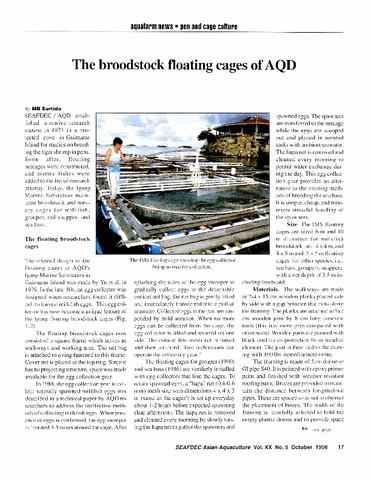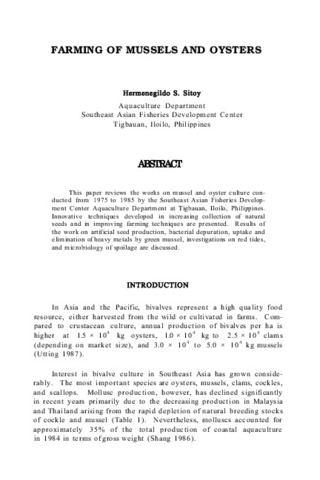2010 and beyond: better seeds for sustainable aquatic food production in Asia.
Share
Abstract
Asia is a major contributor to world aquaculture production. Most Asian countries have maintained their rank in the ten top aquatic food producing nations after developing refined techniques for major commercially important aquaculture species and promoting an increased awareness on the merits of using quality seeds (genetically enhanced or otherwise) as supplied in sufficient quantities. Quality seedstock simply means fit, clean , uniformly-sized seeds which could be eggs, fry, fingerling, juveniles and/or plantlets (for seaweeds) that subsequently express good performance attributes during culture. Beneficial traits refer to good color, shape, growth, efficient feed conversion, high reproduction, tolerance and survival when exposed to stressors (e.g. diseases, poor and/or extreme environmental conditions). Such traits are mostly heritable, hence, quality seeds are usually assumed as produced only by mating stocks perceived or proven to be genetically superior. Some bloodstocks may be genetically mediocre but if bred and manage properly through efficient farm protocols (suitable hatchery, nursery feeding and water management methods), may also produce good quality seeds. Success in the sustainable production of aquatic species for human consumption depends primarily on the availability of seedstock and adoption of optimal husbandry techniques among others. With the intensification of aquaculture systems and the environmental challenges such as those resulting from climate change, it is wise to continue considering both factors -- genetic quality and culture management as equally important in ensuring a steady production of good quality seeds and later, marketable products from aquaculture. Views on what, how and why better quality aquaculture seeds should be produced evolve as times change. To understand these concerns, this paper will cover: (a) the present state of fish seed production in Asia, (b) recent and current seedstock production issues that require attention, and (c) recommendations on how to further enhance aquaculture production in the region in the next decade through better quality seedstock.
Suggested Citation
Romana-Eguia, M. R. R., & de Jesus-Ayson, E. G. T. (2011). 2010 and beyond: better seeds for sustainable aquatic food production in Asia. In B. O. Acosta, R. M. Coloso, E. G. T. de Jesus-Ayson, & J. D. Toledo (Eds.), Sustainable aquaculture development for food security in Southeast Asia towards 2020. Proceedings of the Regional Technical Consultation on Sustainable Aquaculture Development in Southeast Asia Towards 2020 (pp. 1-15). Tigbauan, Iloilo, Philippines: SEAFDEC Aquaculture Department.
Subject
Related items
Showing items related by title, author, creator and subject.
-
The broodstock floating cages of AQD
Surtida, Marilyn B. (Aquaculture Department, Southeast Asian Fisheries Development Center, 1998) -
Aquaculture-based Enhancement and Restoration of Many-colored Abalone Resources (Haliotis diversicolor Reeve, 1846) in Bach Long VI National Marine Protected Area, Vietnam
Chieu, Hoang Dinh; Phuong, Lai Duy; Duy, Do Anh; Tuan, Bui Minh; Thoa, Nguyen Kim (Training Department, Southeast Asian Fisheries Development Center, 2016)Many-colored abalone (Haliotis diversicolor) is high commercial species in Vietnam. Meanwhile, these resources have been over-exploited, thus, artificial breeding was implemented to restore natural abalone resources. After ... -
Farming of mussels and oysters
Sitoy, Hermenegildo S. (Aquaculture Department, Southeast Asian Fisheries Development Center, 1988)This paper reviews the works on mussel and oyster culture conducted from 1975 to 1985 by the Southeast Asian Fisheries Development Center Aquaculture Department at Tigbauan, Iloilo, Philippines. Innovative techniques ...




